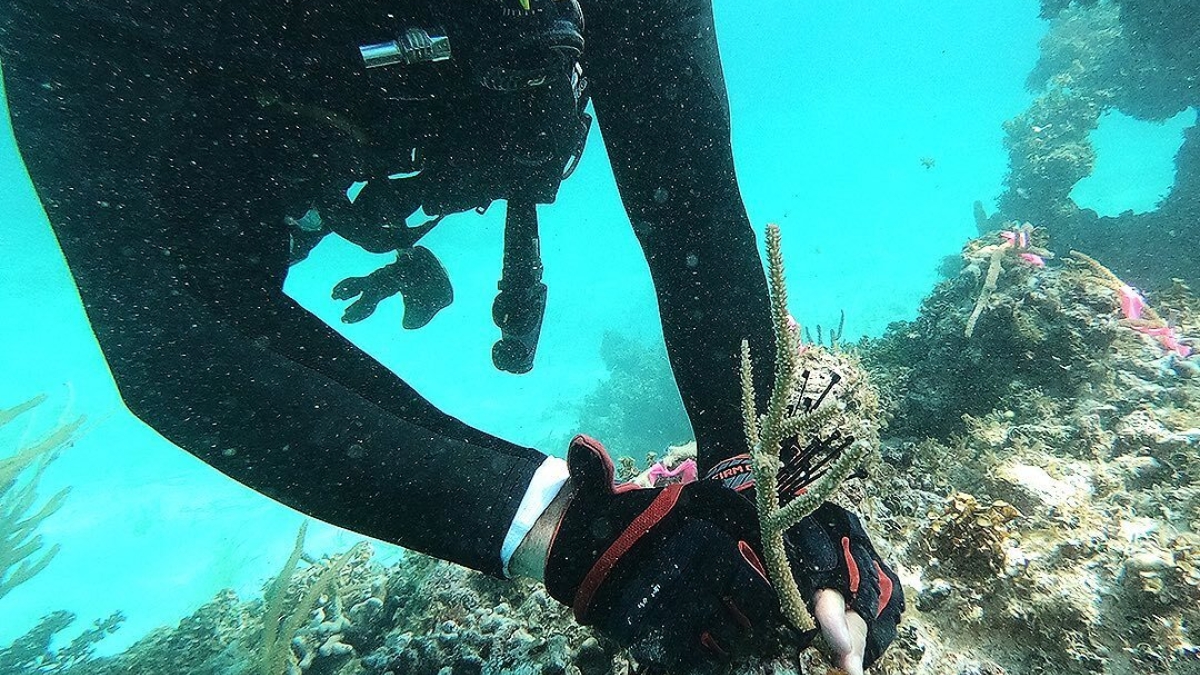New study uses satellites and field studies to improve coral reef restoration

“Coral gardening” or “outplanting” has become a popular and promising solution for restoration.
Our planet’s coral reef ecosystems are in peril from multiple threats. Anthropogenic CO2 has sparked a rise in global average sea surface temperatures, pushing reef survival beyond its upper thermal limits.
Coastal development from industry, aquaculture and infrastructure generates sedimentation and increased turbidity in coastal waters, which raises particulate organic carbon (POC) levels. Additionally, sedimentation reduces photosynthetically active radiation (PAR), the much-needed sunlight soaked up by the symbiotic algae corals rely on for food.
With most of the world’s reefs under stress, “coral gardening” or “outplanting” has become a popular and promising solution for restoration.
Outplanting involves transplanting nursery-grown coral fragments onto degraded reefs. When successful, outplanting helps build coral biomass and restore reef function; but even with thousands of corals outplanted each year, the results are mixed. Newly settled corals are particularly vulnerable to stressors such as pollution, unfavorable light conditions and temperature fluctuations.
Therefore, identifying which stressors have the greatest bearing on coral health and survival is crucial for ensuring successful reef restoration.
A new study published in Restoration Ecology by researchers from Arizona State University’s Center for Global Discovery and Conservation Science found evidence that POC levels are one of the most important factors in determining coral outplant survival. This finding suggests that potential coral outplanting sites should be selected in areas where sedimentation levels are low, away from coastal development, or where coastal development is carefully managed for reef conservation.
“New restoration protocols can use remotely sensed data of multiple oceanographic variables to assess the environmental history of a site. This will help evaluate and optimize site selection and give their outplants the best chance of survival,” said Shawna Foo, lead author and postdoctoral researcher at the ASU center.
The study was based on an analysis of coral outplanting projects worldwide between 1987 and 2019. The team assessed satellite-based data on multiple oceanographic variables including POC, PAR, salinity, sea surface temperature and surface currents to quantify and assess each environmental driver’s relative importance to and influence on coral outplant survival.
"Our results provide, for the first time, a clear set of conditions needed to maximize the success of coral restoration efforts. The findings are based on a vast global dataset and provide a critically needed compass to improving the performance of coral outplants in the future," said Greg Asner, co-author of the study and director of the Center for Global Discovery and Conservation Science.
Notably, the researchers observed better survival rates for corals outplanted farther away from the coast than 6 kilometers. This finding has implications for many restoration projections, which are often located near land for accessibility purposes, such as diving operations.
The researchers also found better coral recovery in water deeper than 6 meters; corals outplanted in shallow waters showed elevated vulnerability to disturbance and bleaching. Overall, coral outplants had the greatest chance of survival in regions with stable PAR, lower levels of POC, minimal temperature anomalies, and increased water depth and distance away from land. The researchers note that finding restoration sites with all of these characteristics could pose a challenge in some areas, but a consideration of all drivers in combination will greatly help the chances of outplant survival.
The study was supported by the John D. and Catherine T. MacArthur Foundation, OceanX and the Avatar Alliance Foundation.
More Science and technology

ASU planetary scientist to be inducted into the National Academy of Sciences
The National Academy of Sciences is inducting School of Earth and Space Exploration Director Meenakshi Wadhwa into the 2023 class…

Unlocking the potential of AI for homeland security
“Can we do what we're doing now cheaper, more efficiently, more effectively?” Adam Cox, director in the Office of Strategy and…

SpaceHACK highlights student solutions to environmental challenges, digital divide
By Adrianna Nine About 250 students from around the world convened online and at Arizona State University on March 22 for the…